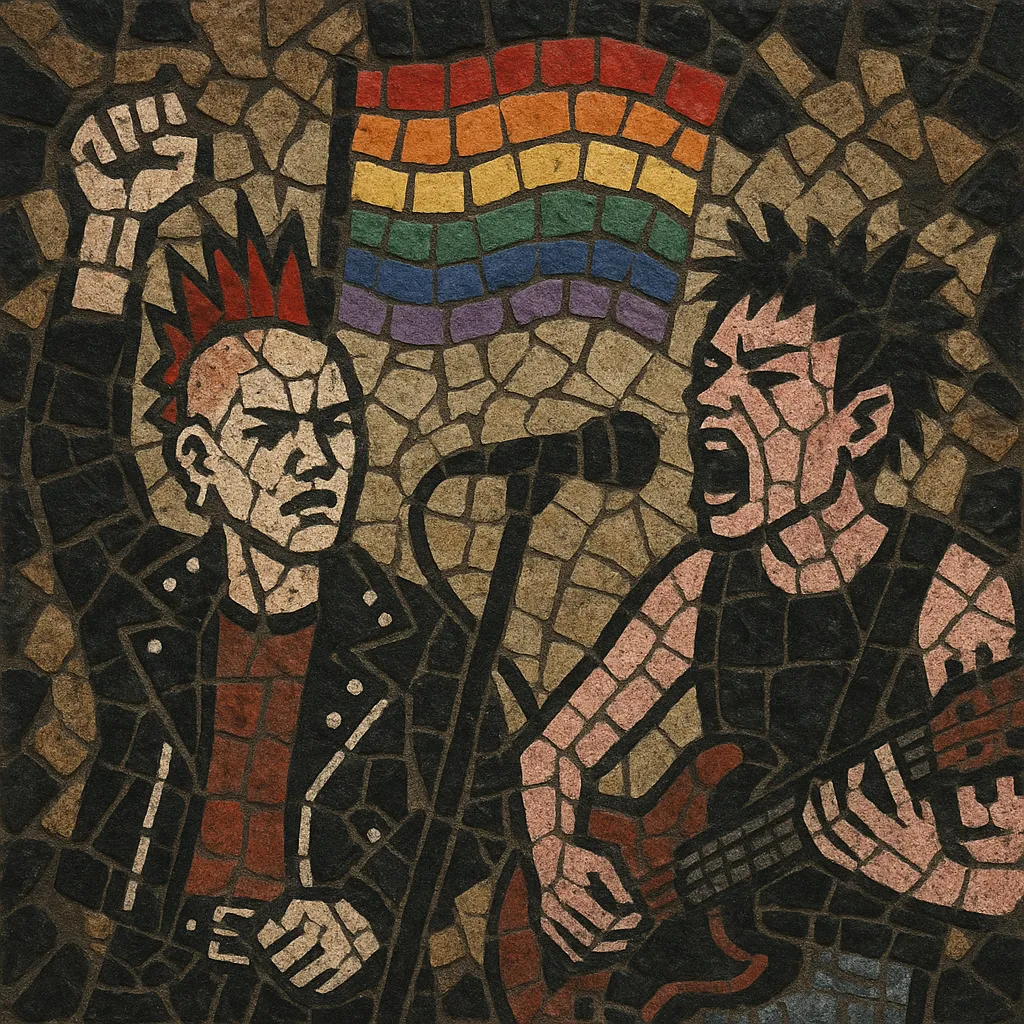Queercore is a punk-derived music and cultural movement that centers LGBTQ+ experiences, politics, and pleasure. Emerging in the mid-1980s as a reaction against both homophobia in punk scenes and assimilationist tendencies in mainstream gay culture, it embraces a DIY ethos across music, zines, film, and community organizing.
Musically, queercore spans from blistering hardcore punk and noisy art-punk to hooky pop‑punk and left‑field indie, with distorted guitars, driving bass, and often shouted or chant-like vocals. Lyrics are frank, confrontational, and frequently witty—tackling sexuality, gender variance, queer desire, anti-fascism, and everyday survival—with a mix of anger, humor, and camp.
Beyond sound, queercore is a scene-building practice: small labels, hand-made zines, all-ages shows, and mutual-aid minded organizing that prioritize safe(r) spaces, consent culture, and queer joy.
Queercore began in the mid-1980s with the Toronto zine J.D.s, created by G.B. Jones and Bruce LaBruce. First calling the movement “homocore,” their writings and compilations criticized both homophobia in punk and conservative currents in gay culture. The term “queercore” soon took hold as a reclamation of “queer,” framing a punk practice rooted in desire, dissent, and DIY media (zines, tapes, and underground film).
Early seeds appeared in and around art‑punk and post‑punk circles, with artists and organizers building small but fervent networks across North America and Europe via mail-order lists, flyers, and zine swaps.
In the early-to-mid 1990s, queercore scenes blossomed in the U.S. West Coast, Pacific Northwest, and East Coast. San Francisco’s Pansy Division popularized a tuneful, openly gay pop‑punk and toured widely (including with Green Day), bringing queer themes to mainstream-adjacent punk audiences. Simultaneously, Team Dresch, Tribe 8, and God Is My Co‑Pilot sharpened the movement’s hardcore/indie edges and explicitly political stance.
Zines and labels like Outpunk amplified the scene, while club nights and fests (e.g., Homocore Chicago events) forged cross-city circuits. There was deep cross‑pollination with riot grrrl and feminist punk, sharing venues, bills, and zine culture while centering different—but allied—political urgencies.
Into the 2000s and 2010s, queercore diversified sonically (from ferocious straight‑edge hardcore to garage-pop and indie) and broadened geographically through the internet’s DIY infrastructure. Bands like Limp Wrist affirmed a proudly queer hardcore lineage, while later acts such as G.L.O.S.S catalyzed a new wave of trans/queer punk visibility and solidarity.
Queercore’s legacy endures less as a fixed style than as a method: unapologetically queer lyrics, mutual-aid minded organizing, and DIY media that keeps stages and floors open to those historically pushed to the margins.
Use a classic punk setup: overdriven electric guitars, electric bass, and a tight drum kit. Favor saturated tones, downpicked power chords, and feedback for menace. Tempos range from hardcore’s 160–220 BPM to pop‑punk’s 130–180 BPM. Keep arrangements compact and high‑impact.
Stick to 4/4 with driving, straight‑ahead beats; incorporate d‑beat or two‑step patterns for hardcore energy. Songs are short (1–3 minutes), with direct verse‑chorus or verse‑refrain structures. Gang vocals, call‑and‑response shouts, and crowd‑ready hooks reinforce community.
Rely on power‑chord progressions (I–bVII–IV, I–IV–V) and modal touches for grit. Melodies can be shouted or sung; contrast harsh verses with catchy, anthemic choruses if leaning pop‑punk. For noisier variants, use dissonance, chromatic runs, and jagged riffs.
Center queer life explicitly: desire, gender euphoria/dysphoria, chosen family, anti‑homophobia, anti‑fascism, sex‑positivity, healthcare, housing, and joy. Balance righteous anger with humor, camp, and wordplay. Use clear, direct language and inclusive pronouns. Don’t shy away from vulnerability or confrontation.
Embrace DIY recording: rehearsal-room takes, minimal overdubs, and honest, present vocals. Mix for impact rather than polish. Release via small labels or self‑publish; pair music with zines, flyers, and community events. Prioritize safer‑space norms, accessible shows, and collectively organized bills.
Project conviction: eye‑level staging, shared mics for gang chants, and participatory moments. Visuals can riff on zine collage, hand‑lettering, camp aesthetics, leather/denim, and punk iconography—reframed through a queer lens.


